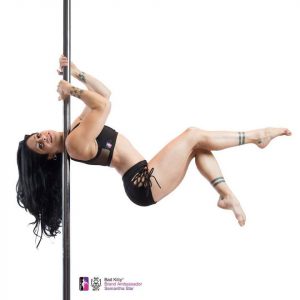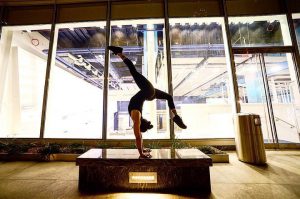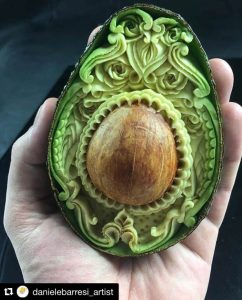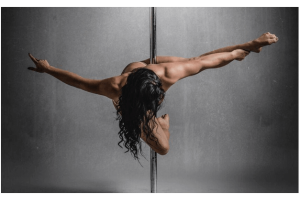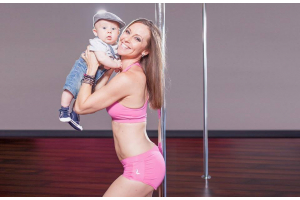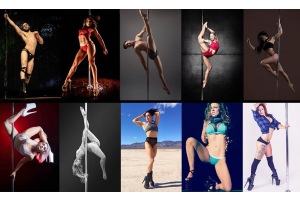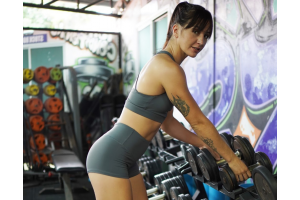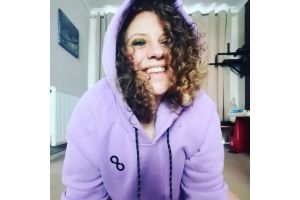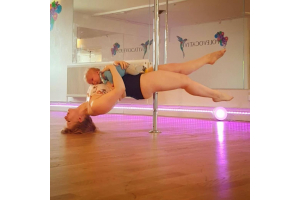Samantha Star Interview | Strength, Flexibility and Handstands | Episode #003
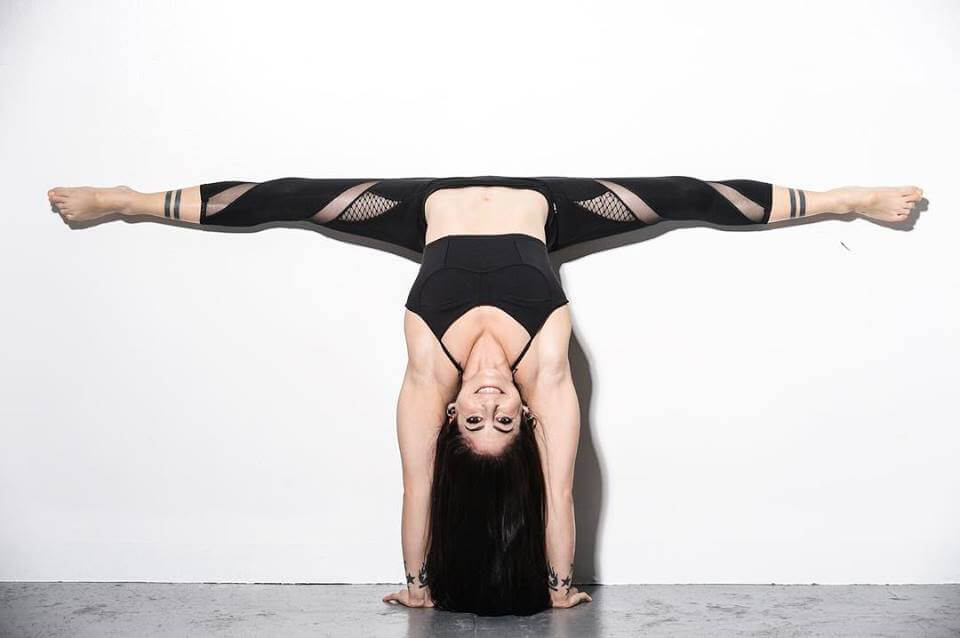
Episode #3 of the Off The Pole Podcast features the immensely talented Samantha Star: cat-whisperer, handstand extraordinaire and lover of avocado art...
This interview was recorded back in July 2017, so some of the events mentioned have already occurred.
Really hope you guys enjoy the 3rd episode in the podcast series - you can subscribe to our pole podcast on iTunes to keep updated with all the latest episodes and it would mean the world to me if you could leave a review!
Hit play above or read the transcript below. You can also check out the video version at the Off The Pole Youtube channel.
Sarah: Welcome, Samantha, thank you for you doing my podcast!
Samantha: Hi. Yay, I'm excited.
Sarah: All the way from New York. You're actually at home for once!
Samantha: I am, I know. For ten minutes...
Sarah: Have you just come back from anywhere? Or are you going off somewhere?
Samantha: I was just in Ireland for the Power to the Pole Camp with Terry and Michael. It was so much fun. I'm actually going to go be a student at Nadia's Insight Movement camp in Seoul, in Korea, next month. I'm really excited.
Sarah: Nice. Yes. It's rare that we get to be students, though.
Samantha: I know. This is one of the new things for me this year is that I'm trying to find more time to go to workshops, go to classes, and soak in more information.
Sarah: I need to do that also. I want to do the Bali camps and things. I want to go somewhere hot as an excuse to just go learn stuff. That sounds awesome.
I normally post (in the OTP Facebook Group) who I'm going to have on the podcast, and then I get an influx of questions. A lot of people just want to know what an average training week looks like for you, because you post a lot of videos, a lot of them are conditioning videos and at CrossFit gyms and handstands and all that stuff. Do you have a split of your training? Do you structure it? Or is it just freestyle?
Samantha: I am kind of a hot mess... I actually don't structure anything or have any real set goals. For me, it depends on what's going on in my life. Right now, this year, I am not competing at all because I kinda needed a break from it, so I've kinda just had more time to play and continue to do things that I find enjoyable and fun, and kind of just maintain what I've gained as far as strength and skillsets go.
It depends I feel like on what's going on in my week at the studio, and then I kind of, depending on how much energy I have left, will depend on how much I end up working out. Also, who's in town and what's going on, and things like that.
I generally work at Body and Pole Friday, Saturday, Sunday and Monday are when my classes are. But then depending on if I pick up a shift, or if a training is happening, or something like that goes on, I may end up having to be there more. I recently, oh, it's probably been actually almost a year. I'm the department head for cross-training and flexibility there, so sometimes I have to do more admin type work. This week we're doing a ring thing, a power monkey ring thing certification training for a class that we teach at the studio called Ring Thing, which is a gymnastics apparatus that is a harness waist belt that's connected to pulley systems and gymnastic rings so it takes half your body weight so you can learn how to do pull-ups or muscles ups or front levers.
Sarah: Oh, nice.
Samantha: It's a really, really fun cross-training class, so there goes my Wednesday and Thursday to do this training, which is awesome, but then I don't get to do my own personal training based on that. But I try to move and do something probably seven days a week. My rest days tend to look more like a restorative yoga class or a lighter handstand training. I have a hard time sitting still.
Sarah: Do you have any of the specific recovery techniques that you do, or do you find that you do that through the movement that you've just said, like through the restorative yoga and things like that?
Samantha: Honestly, sleep. I think sleep is so important, and a lot of people I feel like don't take the time to make time for their sleep properly, so instead of having a rest day where I don't physically do something, I would rather get a solid seven or eight hours on a regular basis, and for me, that seems to help maintain my body and give myself the time that it needs to repair.
Sarah: Do you have to have specific sleep 'brain shut off' systems, because I know some people, they ban themselves from their phone for a specific amount of time or they read or they do meditation or they have a hot bath, or do you find that you can just sleep pretty well once your head hits the pillow?
Samantha: I wear earplugs even when I'm home. Everywhere I travel I always wear earplugs when I sleep, so kind of one of those things where I put them in, I am one of those people that does play on their phone a little bit too long...
Sarah: I think we all are to be honest...
Samantha: When I finally put it down, usually I can fall asleep pretty quickly because of all of the physical activity I've done throughout the day. My body knows that it's time for some rest, but for whatever reason earbuds seem to help kind of zone it out a little bit more.
Sarah: Yeah. Put you in your own little bubble that shuts the whole world out. I can see that.
Samantha: Yeah.
Sarah: Obviously, travelling you take those with you. You seem to be all over the world most of the time. Is there anything you find that you need to do specifically to keep up with your health and fitness as you travel because it must be very difficult to keep up with the amount of conditioning that you do and to keep it at such a high level? Is there anything that you find that you really try and stick to, like make it a consistent in your life, or is it, again, travel just mucks it up and you have to deal with it?
Samantha: Yes, and no. Travel definitely mucks it up a little bit because you're kind of at the whim of other people that you're staying with, locations, time that things are happening. I have, besides getting sleep I have a movement morning practice every day, and it's changed throughout the years, but it's definitely something that I find keeps me at least doing something consistent, and I find that consistency is almost better than me trying to kill myself four hours one day a week. I'd rather do a little bit every day.
My morning practice tends to be from like 10 to 30 minutes depending on where I am and how much time I have and how long I might need to roll on a lacrosse ball that morning or sometimes just breathing and sitting. If I get stuck, sometimes I'll be in a double pigeon stretch on my phone and I'll be like, "I've been here for too long. I should probably switch sides," but yeah. I think my morning practice is probably something that helps at least keep my feeling like I kind of have an understanding of where my body is that day and how to continue. Handstands are a really good way also and you can train anywhere, so if I can't find a gym to hang and do strength/conditioning stuff or a pole to train pole on, you can always find ground or something random to try to handstand on.
Sarah: Yeah, and you're definitely known as the handstand queen. Many, many videos of yours include handstands, normally at airports and stuff like that.
Samantha: Yes.
Sarah: We had a couple of questions from my Facebook group. They were asking about is there any tips that you can give for kind of, especially the fear from moving from a wall handstand to a free standing handstand? I know it's very physical and a lot of it's you have to be somewhere...
Samantha: Cartwheels. Do cartwheels! Honestly, every time you do a handstand, you're falling. It's how you control your fall and if you can understand where your body's going to go in space to then allow you to stay up for longer, slow your fall down, and make it look like you can do something. But a lot of it is this brain fear. I think the wall can be a really amazing tool for learning and strengthening with handstands, but most people use it as a crutch with the brain's fear of "Oh, gosh, I can only use the wall if I'm balancing." Some of it is really learning how to fall and playing with it. There's so many different entrances into cartwheels and I think people sometimes get stuck with one and then just continue to try that same thing over and over again expecting a different result. So yes, you can definitely train stuff on your own, but it's good to go and get some information from a handstand workshop or class every once in a while if not on a regular basis so that way you can glean a little bit more information and then practise, and then the next time you go to a class you'll hear the exact same thing but you'll realise something different from it.
But playing around in the middle of the room and just attempting some kick ups and cartwheeling and understanding how the feel of the cartwheel happens and then where you can go too far in your handstand and you end up in a cartwheel and you fall out and it's safe and it's fine and you can nail your dismount.
Sarah: Definitely.
Samantha: A lot of it really is though just trial and error to some degree. Handstands are a lot, if you watch kids learning how to walk. At first, they get up, they fall over. They're limbs, their legs are literally not strong enough to hold them, and their brainpower doesn't compute to what happens with their legs. It's one of those things where you get up, you fall over, you try again. During this process you start to notice little nuances of, okay, that worked, that didn't work. If you start to pay attention to those you can start to really hone in on why it didn't work, why does it work, and then as you're doing this you build enough strength that you're actually able to start holding stuff.
Sarah: Is it something that you feel like you, even though you've got a very high level of handstands, is it something that you feel like you have to continually work at, or is it something you once you have it it's kind of like standing but upside down.
Samantha: No, that's the thing I love about handstands. There's always something more. You can kind of get good at one section of a skill, but then there's different nuances of even that specific skill. Having a straight body handstand is something that I feel like I will continuously be working on because my line can always be readjusted. Also depending on who you're with, teachers, different practitioners and things like that, everybody has a different thought and variation of what they think is correct. There's so many different nuances of things, and it's something that I think never ends, which is why it's exciting and why you can always continue practising and have a good time. My cat right now is just chilling....
Sarah: She's like, "What are you doing mom? I need some attention."
Samantha: She's like, "But hang out with me." Animals are great handstand helpers, so you do handstands near them and you try not to fall on them. It's a great learning tool. When you get better they get real trusting and you're like, uh.
Sarah: My dog's try and do that but they have much bigger tongues than cats. Like if you get hit with a mastiff tongue it's pretty off-putting.
Samantha: Yeah. Knock you right over, right?
Sarah: Exactly.
Samantha: But yeah, I think with handstands it's a lot of trial and error. I don't know if anybody actually masters it, which is why it's so cool. There are definitely people that are really un-fucking-believable at what they can do, but there's always something else, variations or options or different things or different lengths of time that you can go for.
Sarah: There's a lot of parallels with pole in a sense. It's a bodyweight exercise. There's so many variations for it. I think most of us have seen your Instagram videos of your handstands and you play a lot with very active flexible splits. Are there any kind of common mistakes that you see with pole dancers that so many people are kind of pushing, pushing for their splits and trying to get more flexible, but a lot of time I feel like people miss that kind of functional flexibility that then you can do something with anti-gravity. We can push ourselves into a split on the floor but how can you then translate that to a split? Is there anything that you see, common mistakes people might do?
Samantha: I think the biggest common mistake, there's two in my mind. One is comparing yourself to other people, and the other is giving up because things aren't happening fast enough. Flexibility and strength, both of them, take time and patience. A lot of times you'll be practising and you won't even realise that you're gaining anything and you'll get frustrated, you'll be at that plateau, and then one day you're like, "Oh, shit. I can do this stuff now that I couldn't do before." I teach flexibility classes and I practise a lot of yoga. I'm a little bit more into the crazier, hardcore yoga.
Sarah: Shocking. Shocking that you would say that...
Samantha: That goes into some of the deeper postures. All handstands and all crazy stuff, but it's something that my splits, honestly, I had okay splits. I did gymnastics as a kid and then I didn't do anything for a very long time and then I got back into pole and trying to realise that I was like, "Oh, I should use this now." It's a process. It takes time. Gravity splits, I think are super important. Yeah, if you don't have a flat split on the floor it's not going to magically happen in the air, but if you only train sitting in a split, you're not going to be very good at doing them in a handstand or doing them on an apparatus and getting that flat line that you want. There's a stretch that I do in my classes where you put a yoga block underneath your back when you're laying on the ground, and you try to get your knee to your chest and your extended leg heel to the floor. That extension and lengthen is something that you can't get from sitting in a split.
It's something too that I think two things that made me kind of obsessed with my splits. One, I love jade splits on the pole and my early competition years I used to do jade to jade switches in almost every competition, and none of them were ever flat. I would watch the videos back and be like, "No!" The same thing for my handstand. I'd pop into a handstand split and somebody would take a photo and I'd look at it and be like, "Oh no."
Sarah: "It felt flat when I did it."
Samantha: Yeah. It's something that I kind of got really obsessed with because I was like, "You know what? If I'm doing this stuff I want to be able to do it when I want it anytime," so I also train cold flexibility and what I would call range of motion. It's something that has taken me I would say five or six years to accomplish to where I am today doing something every day to make this achievable. I do flexing forward and some standing split stuff every day, not to where it hurts or where it's difficult, but literally where my range of motion is, and on top of that I do other flexibility and things like this, but throughout the years my starting point range of motion has changed. It started with maybe my split was like this, and now I can do a standing oversplit without trying.
Sarah: Just putting your body in those positions as just a day to day thing rather than a specific training session to build up to it. It's like, just try and get there, try and improve it every day little by little it kind of accumulates.
Samantha: Yeah. The training sessions in between are still just as important.
Sarah: For sure, yeah.
Samantha: But I found, again for me, that say I did two deep flexibility days a week. If I didn't do anything in between I would almost go backwards. My body would seize up on me. What I found that if I can put myself through, and this is part of my morning practice, just deciding that I wanted five moves to just put my body through to see where they were every day has changed where my body can get to without making too much of an effort. It's kind of funny because my cold range of motion flexibility is not to far off from if I warm up for an hour of flexibility. Yes, there's definitely a difference, but it's something that I work on and I really focus in on trying to figure out how to activate my muscles to lengthen my body, and I like to think about it as some people are just naturally flexible and they jump into things. I'm fairly flexible, but I try to muscle my flexibility, which makes me feel better about it. I'm like I can strength this and turn it into something that involves activating and using muscles and strengthening to be able to get into flexibility positions.
Sarah: I think a lot of pole dancers can relate to that because we're all kind of 'doing' people. I think we quite like the whole process of achieving and the challenge and movement, so trying to incorporate that into stretching rather than just sitting in a position on the floor I think makes it a lot more functional for pole. I like the idea of trying the cold positions, just putting your body into it every day rather than having to rely on that one stretch session a week, which most the time isn't actually going to do enough for what we need.
Samantha: Yeah. Something else to be said about that just so people don't try to cram themselves into positions that they're not ready for. When I say range of motion and cold range of motion flexibility, I'm not doing it to where it feels like anything difficult is happening. It's literally just like where my body wants to go naturally and doesn't feel like anything.
Sarah: You're not drop splitting in the kitchen while you're waiting for your ...
Samantha: Well, now I am.
Sarah: Oh, showoff...
Samantha: But, no, it's something too that sometimes, and this is me personally. I don't think flexibility should be painful or miserable.
Sarah: I agree.
Samantha: I think sometimes that some people think that they need to be so uncomfortable when they're doing flexibility training and be in positions that don't feel good to their body because they need to achieve something that somebody else is doing. For me, don't get me wrong, there are definitely some stretchy feels when I'm going into deeper postures and getting myself warm and into things, but there's a difference between pain and stretchy feels. It's something that I think a lot of people don't rely on enough and that's where people get injured and/or don't continue their training because they don't enjoy what they're doing. It's something that I think is, I love stretching. Like, I think it feels good, but I'm not going to push myself into a place where it doesn't feel good. Yeah, that may take me a little bit longer to achieve end goals, but I feel like in the long run it's going to be better for my body and I'm going to be able to do them whenever I want and as much as I want.
Sarah: I think a lot of people find that pole dancers have quite high pain threshold and sometimes will train through more than what hey should do really. Do you have any kind of indicators that you think, "Okay, maybe I've pushed it too far, or this is just natural kind of muscle tightness for my training." How do you gauge when it's over-training versus just everyday pain from training?
Samantha: Again, I don't think there should be pain. I think there should be soreness. I think there can be new feelings, but if I'm in pain, it defeats the entire purpose of what I'm doing, because then I'm not going to be able to do what I love doing for the rest of the week. If I push myself to a place where I physically can't do anything, then I waste an entire week, whereas if I had maybe done a couple less reps or taken it one notch lower, by the end of the week if I continue doing whatever that is, then I can achieve it. But I think sometimes it too. Don't get me wrong, I have injured myself. I have pushed too far, and sometimes doing that is how you learn what your body can do and what your body can't do, unfortunately. If you don't listen to, and that's one of the things, everybody's "Listen to your body," but it's hard to understand what your body is saying if you haven't experienced something too far, which is unfortunate.
Now I try to, I don't know, listen a little bit more. Actually, I would say maybe three months ago I was doing some really deep handstand chest down past where you should go pushups in a handstand with a spot, and I was tired and I probably should have stopped and I didn't, and I jacked up my shoulder. I kind of went around it, and it was one of those things where I could still pull, I could still do a lot of my movements, I could still do handstands, but I couldn't hang from one arm. For me that's miserable, so what I ended up having to do was slowly rehab myself back into that. While I was doing this, it's something that I could still do most of the stuff that I could do on a regular basis. I would say 90% back to action now. There's only maybe one thing that I'm still kind of babying a little bit.
Sarah: Cautious about, yeah.
Samantha: Yeah, because I know that if I push it too far and too fast too soon, then it's going to take me more time to get back to where I want it to be, and if I take it just that little bit slower it's going to be okay. But yeah, sometimes it sucks and it's frustrating when you have an injury or something and you want to do all the things that you know you can do, but at that moment you can't and you have to kind of retract a little bit. I'm not saying don't do anything, because I think, again, for me that's worse if I completely don't move or don't do anything, but what I can do is I can put my feet on the ground and hang with both my arms up with my feet on the ground without weight, and then as it starts to-
Sarah: Adapting the training to suit your body, again listening to it and building it back up so you can be stronger again.
Samantha: Yeah.
Sarah: Do you feel like diet has a big effect on your training as well, and do you change it depending on what you've got coming up? I know you had last year, you were just competing everywhere and touring everywhere and you've just said you are taking a bit more time this year for yourself, so does your diet change or do you stay quiet, "this is my system and this is what I like to eat."
Samantha: I think it depends. It definitely changes based on seasons I think to some degree. Where I'm travelling, what I'm doing, and how I'm feeling. I try to eat things that make me feel good, so I don't really do diets or counting macros or whatever and I don't do supplements. I do eat vitamins and things like that, but not protein powder supplements and things. It's just something I never really understood enough to do. I haven't done the research on it enough, so that's just not something I do for me, but again I kind of have, I guess a boring routine of food.
I think my staples now I'm on a, I wouldn't say a rut, but my system right now, I eat half an avocado and a couple slices of white Monterey Jack cheese or something in the morning after I drink a big glass of lemon water. That's my breakfast.
Sarah: You send me some wonderful pictures. We have mutual avocado love. She sends me these pictures. I'll link them underneath the podcast, but she sends me these intricately carved (avocados), not that she's done... unless you've got a secret talent?
Samantha: No, no. On the internet.
Sarah: These intricately carved avocado pictures that you find on Instagram and then she sends them to me. You came to stay with me for five days and we just lived on avocado. Yeah. Did pull-ups all week. It was a good time.
Samantha: Yeah, it's finding foods that give you energy and make you feel good. If I eat stuff that makes me feel heavy, it's harder to do the stuff I want to do. I, again, change things up when I travel, so I eat a fairly regular diet when I'm here, which is avocados. I always carry around cashews and almonds a bag.
I have peanut butter packets with me most days. That's what I eat during the day. I don't really eat meals, I just snack in between doing things. I eat little snack bar protein bar things. I've been on a dried mango kick lately because I need some candy sugar so that's my sugar, but as odd as it sounds I tend not to eat a lot of sugar except for ice cream.
Sarah: Well, if you're going to do it you might as well do it properly.
Samantha: I feel like ice cream is probably a pretty, especially in the summer when it's warm, is a pretty staple part of my diet, but I don't eat a tonne of carbs unless it's again in fruit or things. I eat a lot of salmon. I do eat a lot of sushi, so I do have some carbs with sushi rice, but I tend to eat pretty minimal and not big portions. Just because for me if I'm, again, doing things non-stop all day, if I'm full I can't press handstand because I'm too full and it feels not as great.
Sarah: That's where I've been going wrong. That's why I can't press it.
Samantha: You've got to snack more.
Sarah: Just got to get my portions down then I can press handstand just like Samantha Star!
Samantha: Everything's going to be different and work differently for different people.
Sarah: Exactly, yeah. I just meant that a lot of people are just more interesting in how other people do it. It's not necessarily like they're going to go off and emulate what you do. They don't know your full training schedule, everyone's body type's different. I think it's more curiousness that people like to just see how other people's bodies work.
Samantha: Lemon water. A big glass of lemon water in the morning I think is super key, also because then it forces you to make sure that you actually drink some water, and then I eat a bigger-ish dinner meal, usually, and then I can't train or do anything. I'm like, "Okay, I'm ready for bed." When I'm getting ready for competitions and things like that, I'll definitely one of my big exciting carb meals that I do, I'll make a big bowl of pasta and do fried eggs and goat cheese and just mash it all up. Usually, I'll do that once or twice a month on my days where I really do rest a little bit more and then immediately after I have to take a nap.
Sarah: Have a little food coma.
Samantha: Yeah. It makes me feel heavier. It's just one of those things. Start to pay attention to how food makes you feel, and I'm not talking about, "Oh, I ate chocolate, so it makes me happy." Not that kind of feelings, which dark chocolate I do eat sometimes.
Sarah: More energy levels rather than the emotion feedback from you, yeah.
Samantha: Testing. There was actually, I went for two months without eating sugar just to see what it would do. I didn't eat ice cream and it was really depressing because I'm like, "But ice cream!"
Sarah: Good for the soul. A few people have said you need to have a glass of red wine, or this is my food that I like. Everyone's got to have that thing that you can still enjoy so it's not too regimented.
Samantha: There you go. I don't drink, so there is that. That's a lot of places that people do waste, I feel like, carbs and sugars and things like that to some degree if you're really working on trying to balance it out, but mostly too, I stopped drinking when I started doing fitness for a living and having to invert every day.
Sarah: You don't want to do that hungover.
Samantha: It made my body feel different and it's one of those things where it's like, what would I rather? Feel like shit and have it take me a couple extra hours to pull my shit together and get my life going, or do I want to handstand first thing in the morning. I want to handstand first thing in the morning.
Sarah: I was going to put my hand up and try and guess, but I think I get it. I know that one! She wants to handstand.
Samantha: But yeah, it's one of those things where if you're interested in seeing what it actually does to your body, a couple years ago I wrote a food journal and I literally just wrote everything that I ate, not caring what it was just to see what I was actually eating. A lot of times you don't realise what you're eating or what the day goes. It was actually kind of interesting. It was actually while I was about to go into competition training, so I had started to pare down what I was eating too. It was a lot of salmon and avocados and eggs. Salmon, avocados, eggs, and nuts I think is what I primarily.
Sarah: Your staples.
Samantha: Yeah. When I travel if people ask when I stay with them what I want, I always say lemons and avocados as my main staples.
Sarah: Then you know you're good.
Samantha: Then I'm good for a little bit. One of the things too, bread and I'm sure I can find good bread in the states, but it's generally pretty processed and not that great, so one of the reasons also that I eat fairly well when I'm home is that when I travel, I can enjoy a little bit of wherever I am's food and I don't feel bad about it. When I'm in Paris I will eat a baguette and a wheel of cheese for breakfast, and croissants. I love croissants, but again it's something that I don't eat on a regular basis because I would like to appreciate them more when I'm travelling. It's kind of like my treat.
Sarah: I think you deserve a treat with all the training you do.
Samantha: Absolutely. It's also interesting because I train less when I travel and I eat more random foods, so when I get home it always take me about a week to get back into the right feeling system sometimes.
Sarah: For sure. Cool, well, I've nearly taken up quite a lot of your time already. That went super, super quick.
Samantha: Yeah, it did.
Sarah: Do you have any last pieces of knowledge bomb advice that you can give for the Off the Pole group, so thinking strength conditioning or things that they could be doing off the pole that could strengthen their pole practice. Say they can only get onto a pole once a week. What could they be doing in between that could benefit their pole?
Samantha: Handstands! Honestly, I think bodyweight conditioning stuff, especially if you don't have a gym or weights or stuff like that, I don't really do a lot of weight stuff. It's more body weight. If you can find a pull-up bar or a playground, hang. Hanging is so good, and playing around with shoulder activation and scap activation and lats and twisting around and monkeying. I think between hanging, pushups, and handstands, you're pretty good. Maybe as you're hanging do some tuck knee raises and toes to bar pike stuff. For me, that's my staple.
Sarah: Awesome. That's definitely something. I think most people can find some kind of access to a pull-up bar and at least they can. They have a floor, they could handstand.
Samantha: Yeah.
Sarah: They can push-up.
Samantha: I think honestly the other thing too I think is most important for me and what's worked best for me is consistency. I don't necessarily need to do two or three hours every day, but I need to do at least five minutes of something every day, and by doing whatever that thing is every single day, I've found I've progressed more in the long run. Yes, I'm not saying that's all you have to do. Still have your couple times a week training sessions of doing other things as well, but if there's one thing that you're like, "I really want this one skill or one buildup to a skill," do it every day. Get obsessed.
Sarah: Get obsessed. Nice. If people want to follow you along and see some of these wonderful handstands themselves, give me a little rundown of where people can find you.
Samantha: On Instagram, because that's probably my favourite platform, @lithiumkitten.
Sarah: I will spell everything and link everything below.
Samantha: I don't know where she went. People always ask they're like, "Lithiumkitten? What's this?" It's my cat's name, so yay.
Sarah: We'll Instagram it up. You've got some very good photos on Instagram.
Samantha: Yeah. Instagram, and then on Facebook I have my athlete page, which is just Samantha Star, and then my personal page which is pretty much just the same thing, which is Samantha Star Cuomo.
Sarah: Awesome. Well, thank you very much for coming on and giving us all of your advice. It's been super helpful and really good insight into a little bit of how you train and what you eat. You're going to have to start posting these intricate avocado designs for everyone to see.
Samantha: I know, right? They're so good! This was fun.
Sarah: Thank you for coming on. Much appreciated. Bye!

